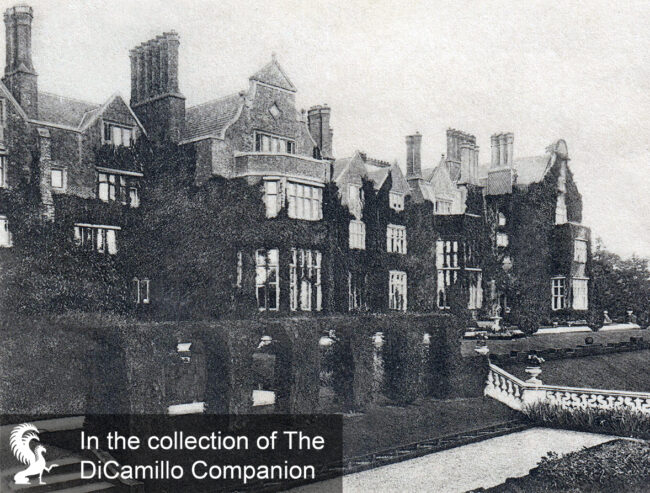
The third house (demolished) from a 1903 postcard
Built / Designed For: 4th Earl of Kenmare
House & Family History: The first house on the estate was Ross Castle, built by in the 15th century by the O'Donoghue family (the ruins are owned by the Office of Public Works and open to the public). This house was replaced as the primary seat of the Browne family by the second house, a 13-bay French chateau style house built nearby to the designs of the 3rd Viscount Kenmare in 1726. The second house had late 18th century additions, which included a ballroom with a painting of Handel being crowned by Orpheus. On August 26, 1861 Valentine, Lord Castlerosse (later 4th Earl of Kenmare), hosted Queen Victoria and Prince Albert at the second house. This house was demolished in 1872 by the 4th Earl, who built a new house (the third house) on a hilltop northwest of the second house. The third house, called Killarney House, was a vast red brick Victorian Tudor style mansion that was, for 40 years, one of the centers of aristocratic Irish hospitality (Mark Bence-Jones called it "...one of the wonders of Ireland...its splendours were legendary"). The third house (see "Images" section), the primary focus of this record, was gutted by fire in 1913 and replaced by the fourth house, a conversion of the 18th century stables of the second house. It was in this house, in the 1920s and 30s, that Viscount Castlerosse, later 6th Earl of Kenmare, entertained the glitterati of the day. Lord Castlerosse was a journalist best known for his influential "Londoner’s Log," which was written for Lord Beaverbrook's Express newspapers. Viscount Castlerosse also laid out a golf course on the estate (today Killarney Golf & Fishing Club) that is considered one of the most beautiful in the world. Wait -- it gets even more confusing! In 1952, upon the death of the 7th and last Earl of Kenmare, the estate was inherited by Beatrice Grosvenor, who sold the fourth house (which still stands) to an American, John McShain, and built, in 1957, a new house--the fifth one! Mrs. Grosvenor lived in this fifth house, built on the site of the third house, until 1974, when she commissioned a sixth house! The fifth and sixth houses, both designed in a simple classical design by Francis Pollen, are extant.
Garden & Outbuildings: In the 18th century the Kenmare estate spanned 137,000 acres.
Architect: Francis Pollen
Date: 1957 & 1974Architect: George Devey
Date: 1872
Title: Guide to Irish Country Houses, A
Author: Bence-Jones, Mark
Year Published: 1988
Reference: pgs. 162-163
Publisher: London: Constable and Company
ISBN: 0094699909
Book Type: Hardback
House Listed: Demolished
Park Listed: Unknown
Past Seat / Home of: SEATED AT FIRST HOUSE: O'Donoghue family, 15th century. Valentine Browne, 1st Viscount Kenmare and 3rd Baronet, until 1694. SEATED AT SECOND HOUSE: Sir Valentine Browne, 3rd Viscount Kenmare and 5th Baronet, 1726-36; Sir Thomas Browne, 4th Viscount Kenmare and 6th Baronet, 1736-95; Valentine Browne, 1st Earl of Kenmare, 1795-1812; Valentine Browne, 2nd Earl of Kenmare, 1812-53; Thomas Browne, 3rd Earl of Kenmare, 1853-71. SEATED AT THIRD HOUSE: Valentine Augustus Browne, 4th Earl of Kenmare, 1871-1905; Valentine Charles Browne, 5th Earl of Kenmare, 1905-13. SEATED AT FOURTH HOUSE: Valentine Charles Browne, 5th Earl of Kenmare, 1913-41; Valentine Edward Charles Browne, 6th Earl of Kenmare, 1941-43; Gerald Ralph Desmond Browne, 7th Earl of Kenmare, 1943-52. John McShain, mid-20th century. SEATED AT FIFTH HOUSE: Beatrice Elizabeth Katherine Grosvenor, 1957-74. SEATED AT SIXTH HOUSE: Beatrice Elizabeth Katherine Grosvenor, 1974-85.
Current Ownership Type: Individual / Family Trust
Primary Current Ownership Use: Demolished
House Open to Public: No
Historic Houses Member: No